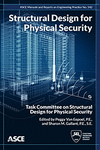Chapter 9
Bridges
Publication: Structural Design for Physical Security: State of the Practice (MOP 142)
Abstract
Protective design measures are typically applied to bridges that are of an iconic nature and/or of asset value to society, or those with a significant cultural or economic value. Therefore, this chapter focuses on features associated with long-span bridges and other important iconic bridge types. It also focuses on applying physical security principles for bridges; threat, vulnerability, and risk assessments; establishment of the Design Basis Threat (DBT); global response of bridges to blast; bridge components, response, and mitigation; and design specifications of new bridges. The particular focus of the last section of this chapter is on the performance of Threat, Vulnerability, and Risk Assessment (TVRA) for a subject bridge that would identify critical, and potentially costly, design requirements.
Get full access to this article
View all available purchase options and get full access to this chapter.
References
AASHTO. 2011. Bridge security guidelines. Washington, DC: AASHTO.
AASHTO. 2017. LRFD bridge design specifications. 8th ed. Washington, DC: AASHTO.
Associated Press. 2009. “Truck bomb destroys key bridge in western Iraq.” October 17, 2009.
Chiarito, V. P., J. K. Minor, R. E. Walker, J. C. Ray, D. C. Guynes, and S. A. Kiger. 2012. Vulnerability of reinforced concrete cable- stayed bridge tower walls to vehicle-borne improvised explosive devices test series 1: Baseline vulnerability tests. ERDC/GSL TR-12-8. FOUO. Vicksburg, MS: US Army Engineer Research and Development Center.
Chiarito, V. P., J. C. Ray, P. Papados, C. P. Rabalais, T. G. Coleman, P. J. O'Connor, and E. M. Weinstein. 2011. Assessment of the vulnerability of cable bundles of cable-stayed bridges to explosive threats. ERDC/GSL TR-11-40. FOUO. Vicksburg, MS: US Army Engineer Research and Development Center.
DA (Department of the Army). 2007. Explosives and demolitions. Field Manual FM 3-34.214 (FM 5-250). Washington, DC: DA.
DoD (US Department of Defense). 2016. Design of buildings to resist progressive collapse. UFC 4-023-03. Washington, DC: DoD.
FHWA (Federal Highway Administration). 2003. Blue ribbon panel on bridge and tunnel security, recommendations for bridge and tunnel security. Washington, DC: FHWA.
FHWA. 2017. Bridge security design manual. Rep. No. FHWA-HIF-17-032. Washington, DC: FHWA.
FHWA. 2018. Primer on impact protection for critical transportation infrastructure. Rep. No. FHWA-HIF-18-054. Washington, DC: FHWA. https://www.fhwa.gov/bridge/security/hif18054.pdf.
GTD (Global Terrorism Database). 2010. National consortium for the study of terrorism and responses to terrorism. College Park, MD: University of Maryland (updated 2017).
Imam, B. M., and M. K. Chryssanthopoulos. 2012. “Causes and consequences of metallic bridge failures.” Struct. Eng. Int. 22 (1): 93–98.
KQED News. 2016. “New state budget allots more money for education.” January 8, 2016.
NCHRP (National Cooperative Highway Research Program). 2008. Blast-resistant highway bridges: Design and detailing guidelines. NCHRP 12-72. Washington, DC: NCHRP.
NCHRP. 2013. Highway bridge fire hazard assessment. NCHRP 12-85. Washington, DC: NCHRP.
PTI (Post Tensioning Institute). 2012. Recommendations for stay cable design, testing and installation. PTI DC45.1-12. Phoenix: PTI.
Ray, J. C., V. P. Chiarito, and S. L. Kinnebrew. 2012. Mitigation of hand-emplaced threats to steel cables and structural steel members. ERDC/GSL TR-12-2. FOUO. Vicksburg, MS: US Army Engineer Research and Development Center.
Sammarco, E. L., E. B. Williamson, and C. E. Davis. 2011. “Enhancing the security of US highway bridges: Developing protective design guidance, tools, and techniques.” TR-News Mag. 275: 12–18.
Starossek, U. 2007. “Disproportionate collapse: A pragmatic approach.” In Proc., Inst. Civ. Eng. Struct. Build. 160 (SB6): 317–325.
Starossek, U. 2009. Progressive collapse of structures. London: Thomas Telford.
Stewart, M. G., and J. Mueller. 2014. “Terrorism risks for bridges in a multi-hazard environment.” Int. J. Prot. Struct. 5 (3): 275–289.
Williamson, E. B., and D. Winget. 2005. “Risk management and design of critical bridges for terrorist attack.” J. Bridge Eng. 10 (1): 96–106.
Information & Authors
Information
Published In
Structural Design for Physical Security: State of the Practice (MOP 142)
Pages: 375 - 406
Editors: Peggy Van Eepoel https://orcid.org/0000-0002-2594-7255 and Sharon M. Gallant https://orcid.org/0000-0002-4261-7661
ISBN (Print): 978-0-7844-1549-8
ISBN (Online): 978-0-7844-8268-1
Copyright
© 2021 American Society of Civil Engineers.
History
Published online: Jun 8, 2021
ASCE Technical Topics:
Authors
Metrics & Citations
Metrics
Citations
Download citation
If you have the appropriate software installed, you can download article citation data to the citation manager of your choice. Simply select your manager software from the list below and click Download.
